The song and other video content explores the building and function of pyramids in Ancient Egypt.
Build that pyramid
Build it up tall
Measure the angles
So the stones don’t fall
Put the stones together
Keep them all neat
Till that pyramid
Is complete!
Calculate with symmetry
Plan proportions carefully
Quarry some limestone, choose your rocks
Cut into enormous blocks!
Build that pyramid… (etc)
Move your stones by sledge or boat
Drag along, or load and float
Teams of people working hard
Bring those stones to the building yard!
Build that pyramid… (etc)
Work together, heave and shift
Ramp those stones up, roll and lift
Step by step, or sloping side
Build that pyramid good and wide
Build that pyramid… (etc, twice)
Refer to the Teacher's Notes for more information about the song, including follow-up music activities based on it and suggestions for cross-curricular study.

This is a tool that the Ancient Egyptians used. See the way it's a bit broken?
Well, that's because it's very old. We call this kind of object an artefact. An artefact gives us a little window into another time and this one helps us travel back nearly 5000 years to the Old Kingdom in Ancient Egypt.
The Ancient Egyptians built pyramids as giant burial tombs for the most important people in their society, the pharaohs.
Inside each of these pyramids is a mummy.
Mummy: Hi ya! You all right?
Not that sort of mummy, I mean the mummified remains of the pharaoh.
Mummy: Oi!
Mummification was the way in which they prepared the body for burial.
This involved removing all of the moisture from the body, including most of the organs which they stored in special jars calledcanopic jars - yuk gross!
The pharaoh's death was seen as the beginning of their journey towards eternal life.
So it was important that their body was preserved to be as lifelike as possible.
The mummified body was buried safely in the pyramid with the items they would need for life after death.
Our artefact was a very important invention that allowed Ancient Egyptians to build the huge pyramids with amazing accuracy and precision.
It's called a set square and plumb line and was used to make sure the pyramids were straight and level from foundations up.
In fact, a very similar tool is still used today for exactly the same thing.
A surveyor working on the pyramid would place the two ends of the wooden set square on a surface and if the weight of the stone, on the plumb line, pulled it down exactly between the two ends of the set square then it was level.
If not? Well then they needed to make adjustments.
Foreman: No good! Next!
Pyramids were built over a period of about 700 years and during that time designs were refined and improved with trial and error.
Pharaoh: Start again!
The first pyramids were 'step' pyramids pioneered by the Pharaoh Djoser, who made his burial tomb taller by stacking stone layers.
Around 50 years later, the Pharaoh Sneferu decided he wanted a smooth finish on the outside of his pyramid.
And so began a kind of competition with each new pharaoh making their pyramid better, stronger and more complex than the one before.
We know who ordered the pyramids but who actually built them?
This was important work that skilled workers took great pride in doing. Farm workers also came to help when the farmland was too wet to work.
The largest pyramids were made with over 2 000 000 blocks of rough yellow limestone that were taken from the ground on site.
Most of the blocks were cut in the ground and then prized out using wooden levers.
To move the heavy stone they used large wooden sleds which they pulled over wet sand.
Exactly how they got the blocks up higher for each level is still a bit of a mystery.
It's thought that they may have used a combination of ramps and a pulley system to heave the sleds up to the height they needed.
It's no accident that the Ancient Egyptians didn't leave any records of how they built the pyramids.
It seems that they wanted them to appear like magical stone mountains from another world.
Wow! They really are impressive.
The Pyramids
Rhys Stephenson explores the pyramids of Ancient Egypt - each a tomb for a pharaoh - and what we know about how they were built.
The video includes the process of mummification and the placement of a pharaoh's body within the pyramid.
It also explores a key tool used by the Ancient Egyptians - the set-square and plumb line - which was used to ensure the pyramids were built with amazing accuracy, giving them the strength that has kept many of them standing to this day.
The video also charts the changing design of pyramids over the centuries from simple 'step' pyramids, to pyramids with smooth sides, to the much larger pyramids of Giza - constructed from over two million blocks of limestone.
Ramy: Hi, I'm Rames. Everyone calls me Ramy. And that over there is my brother User. His name means 'strong'. You can see why he got it. I'm stronger than I look though. That's why I'm going with User and the others to help with the pharaoh's big project.
User has been able to go for a few flood seasons now. But this is the first time I've been old enough to go.
The pharaoh's project is the biggest thing that's ever been built in Egypt and that's why they need all the strong workers, from farms across the Nile Valley, to come and help during Ahket, the flooding season. That's when the land is too wet for farmers to work on. I can't wait to see it.
Wow! Look at that!
What's that?
Foreman: Move it boy, you're here to work, not daydream!
Ramy: This is my first morning on site and there's so much to see. The stone used to build these pyramids is cut directly out the ground, right here on site. So, it doesn't have to move far. Clever, right?
Foreman: Heave!
Ramy: It's so heavy and it moves so slowly. I'm used to hard work on the farm but this is something else.
The problem is that those blades are pushing the sand forward. As we're moving the sled, so the further forward we move the moresand that gathers up. And the harder it is to pull! It's so difficult!
Foreman: Get that boy up. Who brought him here?
Ramy: [Looking at the water soaking into the sand] Will it work?
Foreman: What are you doing? Stop it boy! We need that water.
Ramy: Pull now, look it will work! The wet sand is harder than the soft sand. The sled will side more easily and it won't pull the sand with it. Look, try it! Please. Trust me.
Foreman: OK, we'll try it.
Ramy: Please make it work.
Foreman: Everyone in position and…heave, heave! Bring more water. OK, boy, show us what to do.
Ramy: You see when the sand is wet the tiny spaces in between the grains are filled with water. This makes the sand feel firmer and the sled can move more easily across it.
Now that was a hard day's work!
Foreman: Well done boy, this idea of yours will make things a lot easier. What's your name?
Ramy: Ramy, I mean Rames, sir.
Foreman: Well, Rames, you really helped us out today. Tomorrow we'll bring water directly from the Nile. You can oversee it. I think that might be better suited to your talents than this heavy lifting. Don't you?
Ramy: Thank you, sir. You see it's not only bulging muscles make you strong. I told you I was stronger than I look!
Rames - The Engineer
The video tells the story of Rames, a fictional 12-year-old boy living at the time of the pyramids (c 2580 BC - c 1880 BC).
Rames and his brother User are joining many other farm workers to help with the construction of the pharaoh's 'great project' - his pyramid. The two boys join the teams cleaving the limestone blocks in the quarry and then transporting the blocks by sledge over the desert sand.
It's very hard work because the sand constantly forms a barrier to the smooth sliding of the sledge. But Rames has an idea: if they soak the sand in front of the sledge with water the sledge runners should slide over the surface of the sand.
Rames is right and he is rewarded with the job of organising more water from the River Nile. NB: it is generally agreed that this was a technique adopted by the Ancient Egyptians to ease the movement of sledges across the sand.

Resources
Song: 'Build that pyramid' - Instrumental
Build that pyramid
Build it up tall
Measure the angles
So the stones don’t fall
Put the stones together
Keep them all neat
Till that pyramid
Is complete!
Calculate with symmetry
Plan proportions carefully
Quarry some limestone, choose your rocks
Cut into enormous blocks!
Build that pyramid… (etc)
Move your stones by sledge or boat
Drag along, or load and float
Teams of people working hard
Bring those stones to the building yard!
Build that pyramid… (etc)
Work together, heave and shift
Ramp those stones up, roll and lift
Step by step, or sloping side
Build that pyramid good and wide
Build that pyramid… (etc, twice)
Teacher's Notes. document
Information and guidance on the songs and other content in KS2 Music: Ancient Egypt
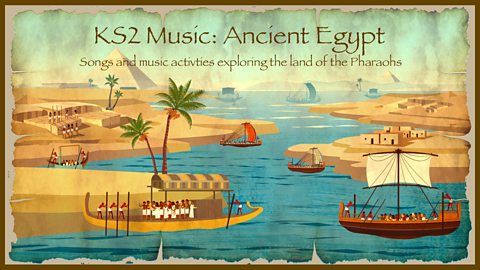
Build that pyramid - Lyrics. document
Print / download the lyric sheet (pdf)
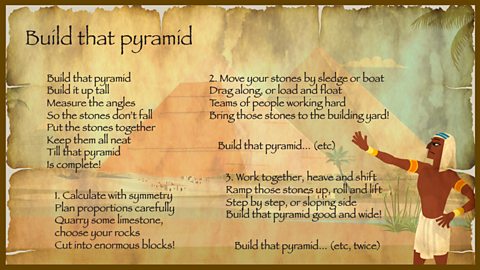
Build that pyramid - Music. document
Print / download the music sheet (pdf)
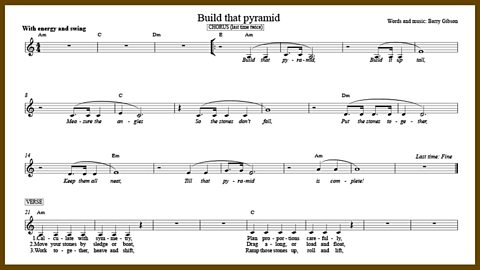
Download audio
Download the backing track of the song (mp3)

Set-square and plumb line. image
Click to display the image full-size
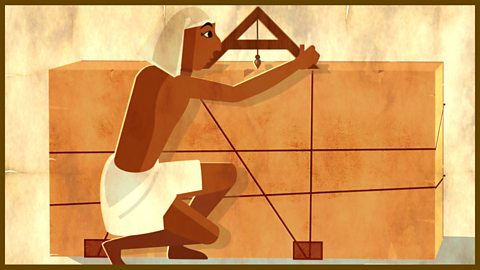

More songs from KS2 Music: Ancient Egypt
Out of the gloom, Tutankhamun
Exploring the life and death of Tutankhamun and the discovery of his tomb in 1922 by Howard Carter.
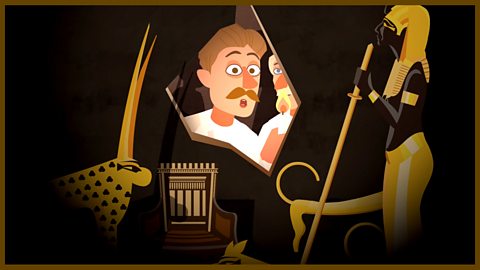
So many gods and goddesses
Covers the rituals and beliefs of the Ancient Egyptians, including their many gods and goddesses.
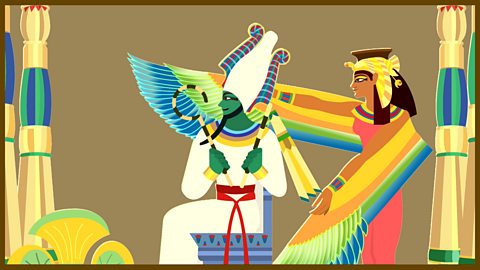
Amulets and hieroglyphs
The song and other video content explores what we know about Ancient Egyptian society and culture.
